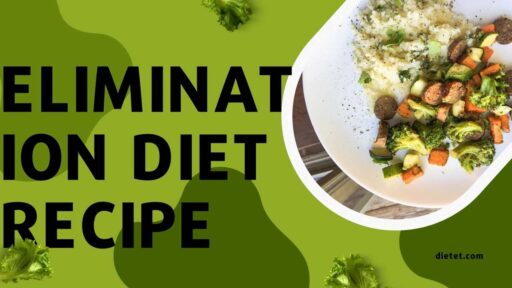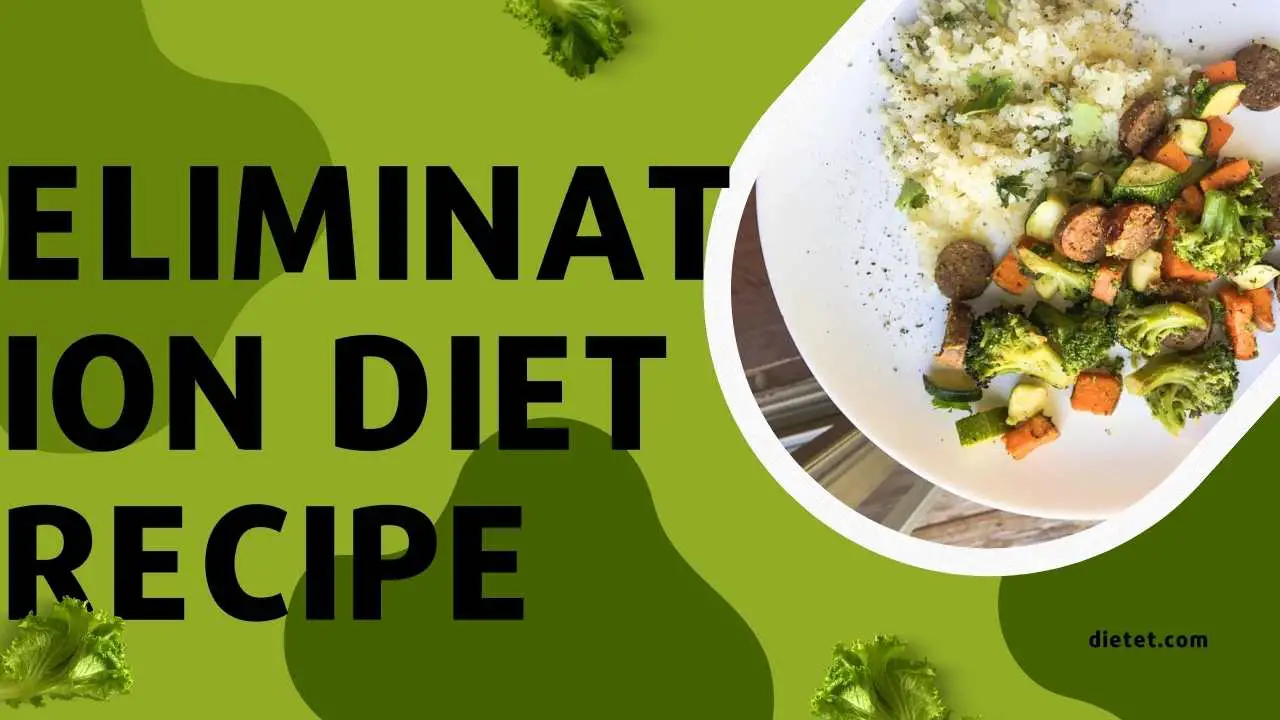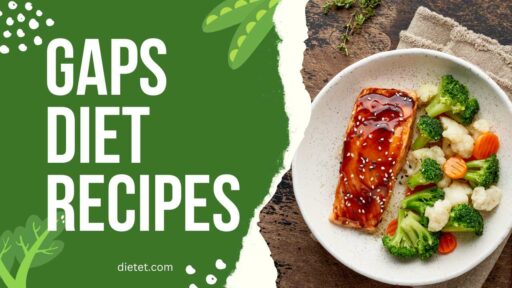Introducing the Elimination Diet Recipe into your culinary repertoire can be life-altering for those looking to identify and minimize food allergies or sensitivities. This approach entails removing specific foods that are known to cause discomfort and then slowly reintroducing them in order to locate any possible negative impacts.
In this blog post, we will examine how the elimination diet works, provide practical recipes for each stage, and give tips on staying motivated through your food discovery journey.
What is an Elimination Diet Recipe?
Sometimes, when it comes to optimizing our health, we need to take a step back and reexamine what we eat. This is where an elimination diet comes in. An elimination diet involves taking out certain foods from your daily menu for some time (for instance 2-6 weeks), then introducing them back slowly so as to know if you have any kind of food sensitivity or allergy.
The point of doing an elimination diet is to afford your body the chance to heal by eliminating inflammatory triggers. When you exclude certain things from your meals, you would know which ones could lead to such unwanted symptoms as skin conditions, digestive problems, bloating, or even fatigue.
Benefits of an Elimination Diet
Partaking in an elimination diet can benefit various aspects of overall health and well-being. First of all, it helps recognize food sensitivities or allergies that may not be known earlier. This information is vital so as not end up eating something that might leave you feeling uncomfortable after making choices about what you intake on a daily basis.
Secondly, going through with it can also reduce inflammation within one’s system, thereby lessening pain-related ailments, including autoimmune diseases, among many others. By removing trigger foods from their diets they help their bodies begin healing and lowered rates of inflammation thus improving overall health.
Ultimately, doing an elimination diet may assist with weight loss too. Wholefoods are associated with naturally regulated bodyweight once processed items are eliminated out of it therefore supporting natural weight regulation mechanisms. Moreover, identification of any food sensitivities can result in weight changes such as reduction or maintenance.
What foods to avoid while on an elimination diet
When practicing an elimination diet, one should ensure that they do not eat some allergens that can trigger adverse reactions among certain individuals. These allergens are:
- Gluten: It is a kind of protein found in barley, rye and wheat which causes digestive complaints and inflammation for individuals with gluten sensitivity as well as celiac disease.
- Dairy: Milk, cheese, etc., contain lactose, a sugar that may be difficult for some people to digest, leading to stomach upset.
- Soy: Soy is a common allergen which is present in many processed foods. Therefore it is important to read carefully the list of ingredients on food packages so as not to include soy-based ones.
- Eggs: Eggs have been identified as the most common allergenic food, especially among children. They can lead to stomach upsets, skin breakouts and even breathing problems for some individuals who have susceptibility towards them.
- Shellfish: Some shellfish species, like shrimp, crab, lobster, etc., are known allergens causing severe allergic reactions in a few people.
Peanuts and tree nuts: Such nuts like almonds, walnuts, and cashews, amongst others, are often responsible for severe allergies.
How to Start an Elimination Diet
People who are new to the elimination diet are often afraid of it at first, but it is possible to make it manageable and worthwhile through proper planning and preparation. Here are some ways you can get started:
- Seek help: Even if you have the strong urge to start an elimination diet, see a healthcare provider or a registered nutritionist. They will offer guidance on how to go about it besides ensuring that you remain healthy in terms of nutrients.
- Develop a schedule: For different meals throughout the day, plan them in advance so that they are varied and delicious and good for you, too! Looking for recipes with no allergens shared and concentrated on whole food would be helpful.
- Empty your cupboards: This assists in avoiding any foods prohibited during elimination. It will prevent temptations helping in keeping up with the program.
- Buy more items for elimination diets: Cram your pantry and fridge with fresh vegetables, fruits, gluten-free grains, lean proteins, healthy fats. This allows easier adherence.
- Maintain a diary of foodstuffs: During exclusion dieting, keep note of what you eat as well as symptoms experienced and changes since then. Therefore, it enables one to identify patterns that may indicate which foods might be causing problems.
Advice for succeeding in an elimination diet
Though embarking on an elimination diet is difficult at times, when favorably approached, one can set oneself up for success. The following recommendations can assist during this process:
- Remember why: You must remind yourself about the positive effects your body undergoes while on such diet this helps to be motivated till it is over.
- Discover new ingredients: This is an opportunity for tasting new foods or ingredients that you have never come across before. In order to keep variety alive in your meals take advantage of all these new recipe ideas when preparing food at home.
- Look towards others who have been there before you: Talk to friends, family members, or online networks made by persons who have either done or are currently doing an elimination diet. Sharing experiences makes it feel less scary.
- Do personal care activities: Some of these are working out, meditating, getting enough sleep, or just taking time away from stressful situations.
Bear in mind that it will take some time before you heal, weeks or even months. Be consistent with your elimination diet, and let the process unfold.
Good and healthy breakfast foods for elimination diets
Breakfast is generally considered the most important meal of the day, and this does not change when one is observing an elimination diet. Here are breakfast recipes that are delicious as well as full of nutrients yet do not include common allergens:
Quinoa Breakfast Bowl
What you’ll need
- 1 cup cooked quinoa
- 1/2 cup unsweetened almond milk
- One tablespoon of chia seeds
- 1/4 cup fresh berries
- 1 tablespoon almond butter
- One teaspoon of honey (optional)
Instructions
In a bowl, mix together the cooked quinoa, almond milk and chia seeds then give it a stir. Let it sit for about 5 minutes and wait for it to thicken.
Serve with fresh berries on top, then drizzle some almond butter and honey if preferred.
Sweet Potato Hash
Ingredients
- 1 large sweet potato peeled and diced
- 1/2 red bell pepper diced
- 1/2 green bell pepper diced
- 1/2 teaspoon of dry thyme
- Salt and pepper according to taste
- Two tablespoons of olive oil
Instructions
Olive oil should be heated in a skillet over medium heat. Add sweet potato, bell peppers, onion, and garlic. Cook until sweet potato is tender, stirring occasionally.
Add paprika, dried thyme, salt, and pepper. Stir to combine and cook for another 2 minutes.
Serve hot as a delicious and filling breakfast option.
Berry Smoothie
Ingredients
- 1 cup unsweetened almond milk
- 1 cup frozen mixed berries
- One tablespoon of almond butter
- One tablespoon of chia seeds
- One teaspoon of honey (optional)
Instructions
In a blender, combine almond milk, frozen mixed berries, almond butter, and chia seeds and blend until smooth and creamy.
- Add honey if desired for sweetness.
- Pour into a glass and enjoy as a refreshing, nutrient-packed breakfast option.
- Mouth Watering Lunch & Dinner Recipes For An Elimination Diet
You can get creative with your elimination diet recipes at lunch and dinner, which are the main meals of the day. However, here are mouth-watering lunch & dinner options that are both delicious and suitable for an elimination diet:
Grilled Chicken with Roasted Veggies
Ingredients
- Two boneless chicken breasts skinless
- Two tablespoons of olive oil divided into two equal parts
- One teaspoon of dried basil leaves crushed into powder form
- One teaspoon dry oregano
- Salt and pepper according to taste requirements
- One cup broccoli florets.
- Cauliflower florets one cup.
- Zucchini cut into 1-inch slices in one cup.
Instructions
- Preheat the grill to a medium-high heat grill.
- Rub chicken breasts with one tablespoon of olive oil, dried basil, dried oregano, salt, and pepper.
- Grill chicken for 6-8 minutes per side or until cooked throughout.
In another bowl toss broccoli cauliflower zucchini remaining olive oil salt and pepper put them on baking sheet then place in preheated oven on 400°F for about 15-20 minutes or until tender.
Serve grilled chicken with roasted veggies for a satisfying and nutrient-rich meal.
Baked Salmon with Lemon and Dill
Ingredients
- Two salmon fillets
- One lemon, sliced
- Two tablespoons fresh dill chopped
- Salt and pepper according to taste requirements
Instructions
- Preheat oven to 400 °F.
- Place salmon fillets on a parchment paper-lined baking sheet.
- Season with salt and pepper, and then sprinkle the fresh dill over the fillets. Place lemon slices on top.
- Bake in the oven for 12-15 minutes or until salmon is cooked through and flakes easily when tested using a fork..
Serve with steamed vegetables or a fresh salad.
Turkey Lettuce Wraps
Ingredients
- 1 lb ground turkey
- One tablespoon coconut amino (gluten-free version of soy sauce)
- A tsp of ground ginger powder
- 2 cloves garlic chopped fine
- A quarter cup of green onions sliced thin
- Lettuce leaves for wrapping – romaine lettuce works great, as does butter lettuce.
Instructions
In a skillet, cook ground turkey over medium heat until browned and cooked through.
- Add coconut amino, ginger content, minced clove garlic & green onions. Stir well together and cook for an additional 2 minutes.
- Spoon the turkey mixture onto lettuce leaves, wrap, and enjoy as a flavorful and satisfying lunch or dinner option.
- Satisfying Snack & Dessert Recipes For An Elimination Diet
Even while following an elimination diet, one can still have snacks and desserts. Below are some very satisfying recipes that will help satisfy your cravings:
Cucumber Avocado Salad
Ingredients
- One cucumber is diced into small cubes.
- One flesh avocado which doesn’t contain pit cut into small cubes,
- Thinly slice a quarter red onion;
- Fresh dill chopped up to 1 tablespoon
- Juice from one lemon squeezed out (juice of one lemon)
- Salt according to taste requirements
Instructions
- In a bowl, combine cucumber, avocado, red onion, and fresh dill.
- Pour in the squeezed lemon juice on top of the mixture and add some salt and pepper. Combine gently by tossing.
- If you want a snack that is both refreshing and nourishing, this can be your best bet.
Banana Nice Cream
Ingredients
- Two ripe bananas, peeled and frozen
- One tablespoon almond butter
- One tablespoon unsweetened cocoa powder (optional)
Instructions
Put frozen bananas, almond butter, and cocoa powder (if using) into a blender or food processor.
- Blend until a smooth ice cream-like mixture forms in the blender or food processor bowl. Occasionally, stop the blending process to enable you to scrape off the sides of the dish.
- Transfer to a bowl where you can enjoy it as a healthy dessert.
Roasted Chickpeas
Ingredients
- One can chickpeas, rinsed and drained
- One tablespoon olive oil
- One teaspoon paprika
- 1/2 teaspoon cumin
- 1/2 teaspoon garlic powder
- Salt and pepper to taste
Instructions
- The oven should be heated to 400°F before anything else.
- Dry chickpeas with a kitchen towel to remove excess moisture from them.
- Mix olive oil, paprika, cumin, garlic powder, and salt and pepper together in a bowl, then toss the chickpeas at them.
- The oven tray should then receive these chickpeas for roasting at 20-25 minutes or when they are crispy enough.
- Allow them to cool before eating; they will become crunchy snacks full of proteins.
Grocery shopping tips for an elimination diet
Among other things involved in observing an elimination diet is grocery shopping, which plays a vital role throughout this journey. Below are some pointers that may help you make sense out of your grocery store trips while still getting what you want:
- Plan ahead: Prior to going shopping for groceries plan your meals so that you come up with a detailed list. It ensures that impulse buying is done away with thus enabling one focus more on their weight loss objectives.
- Careful reading of food labels: Read and understand what the ingredient lists of different foods have to say. Look for those foods that are free from common allergens as well as additives that you want to avoid.
- Concentrate on the exterior borders: Around the grocery store, you will find fresh produce, meat, and dairy alternatives. Emphasize getting unprocessed whole foods for your shopping cart.
- Bulk sections also help: Many bulk sections offer grains, nuts, and seeds, which are often allergy-free. It’s a good place to stock up on pantry staples.
- Consider online shopping: Try doing some shopping online if going to grocery stores has not been easy. Several shops do deliver goods or they can be picked at the stores therefore it is much easier this way.
Getting through Challenges and Staying Motivated
Creating weekly meal plans can be a lifesaver. Establishing a plan for your meals every week saves you from falling back into old eating habits before they can start by simply knowing what you will eat, when, and where throughout your week of elimination dieting.
Meal Prep To The Rescue
Buy high-quality containers for keeping your food fresh; as well as spend few hours over weekend preparing meals for next week .You may feel less stressed out when nutritious ready-to-eat meals are waiting in your refrigerator; thereby there would be no need to be worried about food everyday anymore!
Experiment with New Flavors
Eating bland dishes isn’t necessary just because certain food groups have been removed from your meal plans .Become familiar with herbs and spices that might still seem new to you. This is an opportunity for exploring various tastes around the world that could turn out being great favorites too once discovered during this period.
Connections Matter
Elimination diets can make people feel isolated especially when one is new at it. You are not alone though.” Share experiences online or in local community groups”. Are there any support groups near me? Can I join any online community where I can get tips, recipes and be encouraged?
Find people who move on similar paths as you. There is a lot of information and support out there that can help in making the whole process of an elimination diet less lonely and more interactive.
Supportive strategy
When feeling down, rely on your support system. The presence of someone who acknowledges your dietary restriction is enough motivation to go through this tough journey with determination.
Frequently Ask Question
How long should I follow an elimination diet?
This will depend upon individual needs and goals; therefore, the period for which one ought to undertake an elimination diet is different for each person. You should observe the elimination phase for at least 2-6 weeks and then gradually reintroduce eliminated foods one by one and see how they affect you. This may take several months.
Can I still get all the necessary nutrients while following an elimination diet?
Yes, it’s possible to get all the necessary nutrients while following an elimination diet. Focus on consuming a variety of whole, unprocessed foods, which contain a wide range of nutrients. Seek guidance from healthcare professionals or registered dieticians if you have concerns about meeting your nutritional needs.
Conclusion
An Elimination Diet Recipe can be transformative since it makes us understand better what we eat. By considering recipes and advice mentioned in this article, your journey towards understanding your health better has just begun.
Be patient and persistent as you choose this path. Instead of restricting yourself to meals, make it a culinary adventure led by others in food preparation. Lastly, every small step forward towards well-being should be celebrated no matter how minute.





